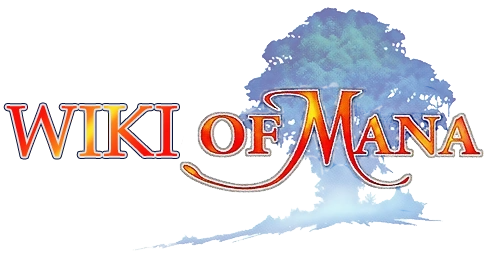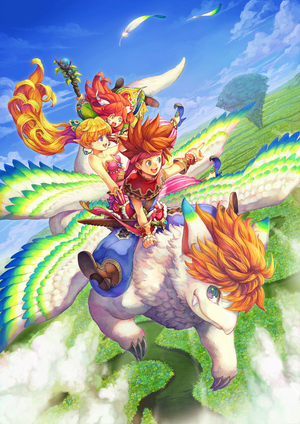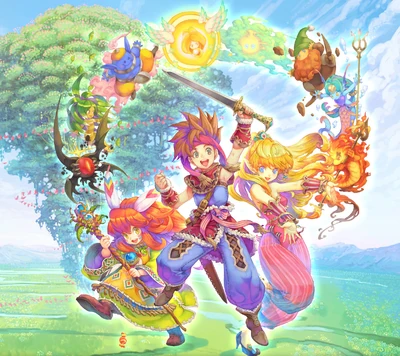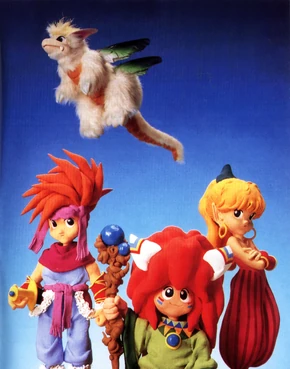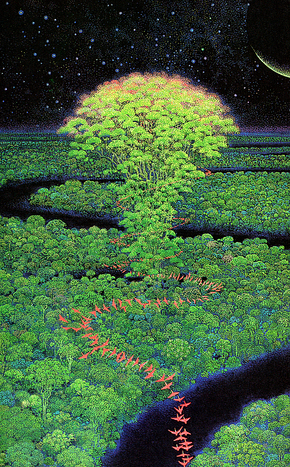Secret of Mana (聖剣伝説2 Seiken Densetsu Tsū, lit. "Holy Sword Legend 2"), is an action role-playing game developed and published by Squaresoft (now Square Enix) for the Super Nintendo Entertainment System. It was directed by Koichi Ishii and programmed by Nasir Gebelli.
Secret of Mana is the second installment in the Mana video game series. This is the only Mana game released on the SNES outside Japan. Most players outside Japan were introduced to the series through this particular game. It was later re-released on the Wii Virtual Console, Apple's iOS, and Android.
Rather than use the traditional turn-based battle system of games like Final Fantasy and Dragon Quest, Secret of Mana uses real-time battles akin to the Legend of Zelda series' games, but with a stamina bar mechanic, the statistical-based elements of the RPG genre, a unique "ring menu" system, and co-op multiplayer. With its brightly colored graphics, expansive plot, and soundtrack by Hiroki Kikuta, Secret of Mana is considered an influential game of its time.
The game's graphical style and overworld battles were adopted by Chrono Trigger. The stamina bar mechanic was later adopted by a number of action RPGs, including King's Field, Demon's Souls, Dark Souls, Bloodborne and Nioh. The ring menu system was adopted by Temple of Elemental Evil, and the co-op multiplayer system was adopted by Dungeon Siege III.
Gameplay
As is common with role-playing games of the 16-bit era, Secret of Mana is comprised entirely of a top-down perspective, in which three protagonists (a boy, a girl, and a sprite) navigate through the terrain and fight off hostile creatures. Control may be passed between each of the three at any time. When one character is selected as the player character, his two companions will be controlled via artificial intelligence, and vice-versa. The trio can find refuge in towns, where they can regain hit points (HP) or purchase restorative items and equipment. The game may be played simultaneously by two or three players.
Each of the three characters has individual strengths and weaknesses: The boy, while unable to use magic, excels at fighting and masters weapons at a quicker rate; the girl functions as healer, able to cast restorative and support spells but has average combat abilities; lastly, the Sprite's magic is almost entirely offensive and highly destructive, but it is ill-suited for melee combat. Upon collecting enough experience points in battle, each character will increase in level with improved stats such as strength and evasion. Options such as changing armor and/or weapons, using items, casting spells, or checking status is performed by cycling through the game's Ring Menu, a circular menu that hovers over the currently-controlled party member. The game is momentarily paused when the Action Ring appears.
Fighting Through the World
Combat takes place in real-time. Located below each character's hit points is a percentage gauge that determines the amount of damage done to an enemy. Swinging a weapon causes the gauge to fall to 0% and then quickly recharge, allowing that character to attack at full strength. The party wields eight different styles of weapons throughout the game: sword, spear, bow, axe, boomerang, glove, whip, and javelin. With the exception of the sword, all weapons can be upgraded eight times, and repeated use increases their Skill Levels to a maximum of 8, unlocking a new charged attack with each level. Weapons are upgraded through the use of Weapon Orbs, generally obtained after defeating a boss or found as a treasure in dungeons. Once an Orb is collected, the weapon must be taken to Watts to be reforged.
Magic in Secret of Mana operates in much the same way as weapon skill progression, with the exception that magic points are consumed each time a spell in cast. In order to learn magic, the party must rescue spirits known as Mana Elementals. The eight Elementals represent different elements (Fire, Water, Earth, etc.), and each provides the player with specific spells. Magic skill can only be as high as the party's current Mana Power, which increases every time the party reseals one of the mana seeds during the course of the game.
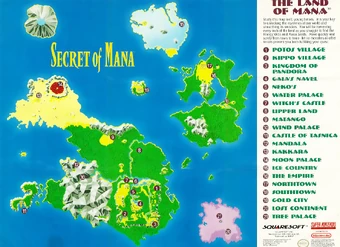
World map half of the double-sided Nintendo Power poster
Unlike most console role-playing games of the time, Secret of Mana does not switch to an overworld map each time the characters leave a dungeon or town. From the start of the game, players must traverse an enemy-infested countryside in order to reach their next destination. Travel may be expedited through use of Cannon Travel Centers, where non-player characters offer to launch the party (via a giant cannon) to a far-away destination. Cannon-travel usually requires a fee, but is mandatory to visit other continents early on. Later, the party is given access to Flammie, a type of dragon that is controlled by the player and can fly anywhere. These sequences make use of the Super Nintendo's Mode 7 capability to create a rotatable background, giving the illusion that the ground beneath Flammie is rendered in three dimensions. Also, while on Flammie, the player can access either the "rotated map", which presents the world as a globe, or the "world map," a two-dimensional view of the overworld.
Plot
Setting
The story takes place in a fictional world, during an unspecified period following a war between a civilization and "gods" concerning the use of mana to fuel the "Mana Fortress", a flying warship. Using the power of the Mana Sword, a hero destroyed the fortress and returned peace to the world.
Story
The story begins when three boys from the village Potos disobey their Elder's instructions and trespass into a nearby waterfall, where a treasure is said to be kept. One of the boys stumbles and falls to the bottom of the waterfall, where he finds a rusty sword embedded in a stone. Guided by a disembodied voice, he pulls the sword free, inadvertently unleashing monsters in Potos and the surrounding countryside. The villagers interpret the sword's removal as a bad omen, and banish Randi from Potos forever. An elderly Knight named Jema recognizes the blade as the legendary Mana Sword, and encourages Randi to re-energize it by visiting the eight Mana Temples. During his journey, Randi is joined by Popoi, a Sprite child, and Primm, the daughter of Elman (a resident of the kingdom of Pandora, possibly a nobleman). The Popoi initially tries to con Randi out of his money, but later accompanies him in hope of recovering his lost memory. Primm joins the party in search of her lost love, Dyluck, an officer in Pandora's army who has gone missing.
Throughout their travels, the trio is pursued by the Empire, which seeks to unseal the eight Mana Seeds and revive the Mana Fortress. Unbeknownst to the Emperor and several of his strongest subordinates, they are being manipulated by Thanatos, an ancient sorcerer who has offered to help them take over the world. Due to his own body's deterioration, Thanatos is in need of a suitable body to possess. After putting the entire kingdom of Pandora under a trance, he abducts two candidates: Dyluck, now enslaved, and a young Pandoran girl named Phanna. Over time, however, Thanatos narrows his selection to Dyluck.
The Empire succeeds in unsealing all eight Mana Seeds. However, Thanatos betrays the Emperor and his henchmen, killing them and seizing control of the Mana Fortress for himself. Randi and his party journey to the Pure Land, the focal point of the world's Mana energy. Anticipating their arrival, Thanatos positions the Mana Fortress over the Mana Tree and destroys it. The charred remains of the Tree speak to the party, explaining that a giant creature called the Mana Beast will soon be summoned to destroy the Fortress. However, the Beast has little control over its rage and will likely destroy the world as well. The Mana Tree then reveals that it is comprised of the souls of women of a chosen lineage, currently speaking with the voice of the boy's mother who is also wife of Serin — the original Mana Knight. The voice heard at Potos' waterfall was that of Serin's ghost — Randi's father.
The trio flies to the Mana Fortress and confronts Thanatos, who is preparing to transfer his mind into Dyluck. With the last of his strength, Dyluck warns that Thanatos has sold his soul to the underworld and must not be allowed to have the Fortress. Dyluck kills himself, forcing Thanatos to revert to a skeletal lich-form which is quickly defeated in battle. The Mana Beast finally reveals itself and attacks the Fortress. Randi expresses reluctance to kill the Beast, fearing that with the dispersal of Mana from the world, the Popoi will vanish. With Popoi's encouragement, the boy uses the fully-energized Mana Sword to slay the Beast, causing it to explode and transform into snow. At the conclusion of the game, Randi is shown returning the Mana Sword to its place beneath the waterfall.
Characters
The primary protagonist of Secret of Mana is the boy, who is supported by the spell-casting girl and sprite child. While the three released versions of the game do not have a default name for each of the characters, the Japanese instruction manual refers to the boy, girl and sprite respectively as Randi, Primm and Popoi (or variants thereof). The origin of the heroes' names is somewhat cloudy: they were possibly bestowed by the Japanese Gamest Magazine previewing the game, then followed upon by other magazines and subsequently by Square.
Randi, a.k.a. Randy, the Boy is adopted by the Elder of Potos after his mother disappears. After Randi pulled out the Mana Sword free, the monsters invaded Potos and the villagers persuade the Elder to banish him. Now Randi embarks on his mission with his two new friends to restore the Mana Sword.
Primm, a.k.a. Purim, the Girl meets Randi briefly when he's ambushed by Goblins. After helping him escape, she disappears, only to appear again outside Elinee's Castle. Primm is in love with a warrior named Dyluck, who was ordered by the King to infiltrate Elinee's Castle. Angry with her father and the king for this, as well as setting her up for an arranged marriage, she rebels and leaves the castle to join Randi in his quest, hoping to save Dyluck as well. She is capable of casting defensive and healing spells.
Primm can also be found when the main protagonist enters Pandora castle to meet up with Jema and the king. If she has rescued Randi from the goblins already, she will recruit him to help her find Dyluck, thus skipping what (at this point in the game) is one of the hardest battles the player will face.
Popoi, a.k.a. Popoie, the Sprite at the Dwarf Village who makes a living by scamming people at the dwarves' Freak Show. As he had lost his memory of his past due to the flood to Gaia's Navel, he joins the party with Randi to refresh his memories. Popoi may seem childish at times and is a bit of a smartmouth, but he has courage equal to that of the other two heroes. Popoi's gender has never officially been stated; however, in the Japanese version's script, he uses the first-person pronoun "oira" that is mostly used by male speakers. He is capable of casting offensive spells.
Each time when the players encounter one of the 8 Mana Spirits, they will offer their services to both Primm and Popoi to cast Magic.
Development
Secret of Mana was directed and designed by Koichi Ishii. The game was programmed primarily by Nasir Gebelli and produced by veteran Squaresoft designer Hiromichi Tanaka. After the release of Final Fantasy III, Tanaka wanted to help design a seamless game without a separate battle system. Because this would not work with Final Fantasy IV, he turned to Secret of Mana. Secret of Mana was originally going to be a launch title for the SNES CD add-on, but after the project was dropped, the game had to be altered to fit onto a standard game cartridge. Koichi has estimated that as much as 40% of the game was excised to fit it onto an SNES cartridge, and Hiromachi stated that the original story was much deeper and darker in tone, and that there was simply no room to do any character development in the shrunken game.
According to Tanaka in 2011 and 2013, the game was originally intended to be Final Fantasy IV, before becoming a new project called Chrono Trigger, and then eventually Secret of Mana. In his own words:
“After we finished FFIII, we started FFIV with the idea of a slightly more action-based, dynamic overworld rather than keep combat as a completely separate thing. But, at some point, it wound up not being IV anymore… Instead, it was eventually released as “Seiken Densetsu 2″ (Secret of Mana), but during development it was actually referred to as “Chrono Trigger”. (laugh)
At the time, just after FFIII, we were working with Mr. Toriyama on a game with a seamless, side-view system. A CD-ROM attachment for the Super Famicom was scheduled to be released, you see. So we had this enormous game planned out for the CD-ROM attachment, but ultimately we were never able to release it.
So we had the Chrono Trigger project changed to a new game, and this other game we had been working on was condensed down into Seiken Densetsu 2. Because of this, Seiken 2 always felt like a sequel to FFIII to me.”
—Hiromichi Tanaka
The English translation for Secret of Mana was completed in only 30 days, mere weeks after the Japanese release. This was presumably so that the game could be released in North America for the 1993 holiday season. According to translator Ted Woolsey, a large portion of the game's script was cut out in the English localization due to space limitations and a lack of sequential text. The English translation of Secret of Mana uses a fixed-width font to display text on the main gameplay screen. However, the choice of this font limits the amount of space available to display text, and as a result conversations are trimmed to their bare essentials, leaving a good portion of the game lost in translation.
In 1999 as part of their planned nine game lineup, Square announced they would be porting Seiken Densetsu 2 to Bandai's new handheld system WonderSwan Color. The port was delayed and eventually cancelled when Square moved resources to Game Boy Advance development.
Audio
Secret of Mana Original Soundtrack (聖剣伝説2 オリジナル・サウンド・ヴァージョン, Seiken Densetsu 2 Orijinaru Soundo Vājion) is the soundtrack to Secret of Mana. Originally released in 1993 in Japan under the name Seiken Densetsu 2 Original Sound Version by NTT Publishing and Squaresoft, its U.S. debut followed in the next year due to the game's massive success. The U.S. release is identical to the Japanese version, aside from the packaging and localized English song titles (not necessarily accurate translations). It was re-released in both 1995 and 2004.
The game's soundtrack was composed by Hiroki Kikuta. It is known for its variety of tunes which tend to focus on the use of percussion and woodwind instruments, ranging from a lighthearted dwarves' polka to a somber, wistful snow melody to a tribal-like dance. Kikuta states that he had a particularly difficult time composing the score, which required him to combine his own style of popular music with the "game music" that is accompanied by the hardware and software limitation of the Super Famicom.
Secret of Mana's title theme, "Angels' Fear" is well known by video game music aficionados for its haunting, echoing piano melody, and was featured in the third Orchestral Game Concert and the fifth Symphonic Game Music Concert, as well as serving as the base for many remixes. In 2008, ScrewAttack.com's users ranked the song number 7 on the website's Top 10 Video Game Themes Ever.
Parts of the game's soundtrack, as well as some music from Seiken Densetsu 3, were incorporated into the Secret of Mana + compilation arrangement CD, an image album containing one 50-minute track.
| Secret of Mana Original Soundtrack Tracklist |
|---|
Disc 1 (54:42)
|
See also
Gallery
External links
| v · e · d |
|---|
| Main Series |
| Collection of Mana (Final Fantasy Adventure · Secret of Mana · Trials of Mana) · Dawn of Mana · Visions of Mana |
| Spin-offs |
| Legend of Mana · Children of Mana · Friends of Mana · Heroes of Mana · Circle of Mana · Rise of Mana · Echoes of Mana |
| Remakes |
| Sword of Mana · Adventures of Mana · Secret of Mana (2018) · Trials of Mana (2020) · Legend of Mana (2021) |
| Cancelled |
| The Emergence of Excalibur · Sword of Mana 2 |
| This page uses content from Wikipedia. The original article is at Secret of Mana. The list of authors can be seen in the page history. As with Wiki of Mana, the text of Wikipedia is available under the GNU Free Documentation License. |
